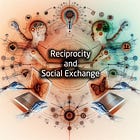Navigating Emotional Intelligence and Artificial Intelligence in the Digital Landscape
The Social Fabric of the Digital World
Preface
The journey continues in Part 2 with the notions of psychology and sociology being further explored in the context of trust and technological transformation. As another foundational layer in the understanding of trust, this essay serves as an aggregation of the previous essays along the same themes of how our interactions with each other are shaped by our technologies. By unpacking the psychological and social pillars of trust, there are opportunities to better equip ourselves to build robust and meaningful connections in the face of technological change. As with all explorations, not all paths lead to treasure. The value and treasure is in the path itself.
Introduction
The digital age has ushered in an evolution of communication, connecting individuals across continents and social circles with unprecedented ease. However, this very speed and scale present unique challenges in establishing and maintaining trust. Unlike face-to-face interactions, where nonverbal cues play a crucial role in understanding intent and emotion, digital communication often lacks this vital context. This absence can lead to misunderstandings, frustration, and difficulty gauging the true state of mind of the communicator. In certain cases, further compounding this challenge is the uncertainty surrounding the identity of online communicators in anonymous digital spaces.
With the aim to navigate these complexities and build authentic connections, a multidisciplinary approach is required. This essay explores three key areas:
The Foundation of Trust in Digital Communication: This section examines the role of emotional intelligence (EQ) in navigating the limitations of text-based communication and anonymous interactions.
Navigating Trust in AI-Mediated Communication: This section explores the potential benefits and drawbacks of AI tools in communication platforms, particularly regarding their impact on trust.
Building Trust in Online Communities: This section delves into the concept of social capital and explores how platform design, user behavior, and responsible AI use can foster trust and collaboration within online communities.
I. The Foundation of Trust in Digital Communication
The internet has become a ubiquitous web of connection, collapsing physical distances and dissolving social circles into a constant hum of digital exchange. However, Trust, the lifeblood of meaningful connection, seems to atrophy in the digital ether. Digital communication often lacks vital emotional context. And when cloaked in the digitization of the web, navigating the nuances of human connection becomes an exercise in deciphering a cryptic code.
The answer lies not in technological innovation, but in a distinctly human capacity: emotional intelligence (EQ)1. EQ, the ability to navigate the labyrinth of human emotions, both one's own and those of others, serves as the cipher for decoding the complexities of digital communication. By honing EQ, individuals can bridge the gap between the sterile efficiency of text and the rich tapestry of human interaction. It's about learning to read between the lines, to discern the subtleties of emotion beneath the surface of a message. It's about fostering empathy, stepping into the digital shoes of the person on the other side of the screen.
In this new age of hyperconnectivity, where trust is a fragile commodity, cultivating emotional intelligence is not a luxury – it's a necessity. It's the key to unlocking genuine connection and ensuring that messages are not just heard, but truly understood.
Emotional Regulation
One critical aspect of EQ is emotional regulation. Emotional responses significantly impact how individuals communicate and how their messages are interpreted. In the heat of the moment, a poorly chosen word or a hastily sent message can damage trust. Effective emotional regulation allows individuals to take a step back, assess the situation, and respond in a way that is clear, concise, and respectful. This prevents impulsive reactions triggered by misinterpreted messages, fostering trust and creating a foundation for productive communication.
For example, imagine receiving an email from a colleague with a seemingly accusatory tone. Without the benefit of nonverbal cues, it's easy to misinterpret their intent. By exercising emotional regulation, one can choose to pause, reread the email, and perhaps draft a clarifying response before hitting send. This demonstrates the ability to manage emotions in the face of potential conflict, fostering trust and promoting a productive resolution.
Self-Awareness
Another key element of EQ is self-awareness. This involves understanding one's own emotional triggers and how they might influence communication style. When individuals are aware of their emotional vulnerabilities, they can proactively adjust their approach to build trust. For instance, if someone knows that sarcasm often translates poorly online, they can opt for a more direct or, perhaps, a humorous approach to convey their point effectively.
Self-awareness also allows individuals to recognize instances where emotions might cloud judgment. When faced with a heated online discussion, understanding one's own emotional state allows them to step back, de-escalate the situation, and potentially revisit the conversation later when emotions have subsided. This demonstrates a commitment to clear and well-considered communication, strengthening trust and fostering a more positive online environment.
Assertive Communication
Assertive communication2 is a key ingredient for building trust in digital platforms. It rests on three pillars: direct and honest expression, respect for all participants, and setting clear boundaries.
Direct and Honest Expression: Straightforward and honest communication minimizes ambiguity and the risk of misunderstandings, particularly important online where interpretations can be easily skewed. A simple statement like "I appreciate your feedback, but I disagree with your approach" conveys a perspective clearly while acknowledging the other's viewpoint. This fosters trust by demonstrating a commitment to open and honest dialogue.
Respect for All Participants: Assertiveness is not synonymous with aggression. It necessitates respect for both oneself and others. This translates to respectful language even in disagreement, acknowledging the other person's perspective, and avoiding personal attacks. By nurturing a respectful online environment, a sense of security is established for everyone involved, encouraging open communication and strengthening trust.
Setting Clear Boundaries: Clearly defined boundaries are essential for managing expectations and avoiding resentment. This includes communicating availability for online interactions, setting deadlines for responses, and politely declining requests that fall outside one's comfort zone. Establishing boundaries demonstrates respect for one's own time and energy, as well as for the time and energy of others. This fosters trust as it creates a predictable and respectful foundation for online interactions.
Allure and Limitations of AI
While Artificial Intelligence (AI) holds immense potential to enhance communication, its limitations must be acknowledged. AI tools can analyze vast amounts of data and suggest prompts or feedback that could contribute to the development of assertive communication skills. However, an overreliance on AI can be detrimental. Constant dependence on AI-generated communication risks hindering the development of individual emotional intelligence and the ability to adapt communication styles to specific situations.
The foundation of trust using digital communications lies in the ability to navigate the complexities of online interactions. By cultivating emotional intelligence, practicing assertive communication, and recognizing the limitations of AI, genuine and trusting connections can be built in digitally.
II. Navigating Trust in AI-Mediated Communication
The proliferation of AI tools within communication platforms3 has fundamentally reshaped online interactions. While AI offers expansive possibilities for enhanced communication, it also presents novel challenges in establishing and maintaining trust.
AI and Emotion
AI has the capability to analyze vast amounts of data to identify emotional cues within text-based communication. These algorithms can recognize patterns in language that might signal frustration, sarcasm, or confusion, potentially leading to a reduction in misunderstandings. For example, a customer service chatbot powered by AI could analyze a customer's message and identify potential frustration based on keywords and sentence structure. By flagging such messages, the AI could route the customer to a human representative better equipped to handle the situation.
However, ethical considerations arise when AI chatbots are programmed to mimic human interaction too closely. While a chatbot's ability to express empathy or humor might seem beneficial on the surface, it can create a deceptive sense of trust. When the limitations of the technology become apparent, the user might feel misled, potentially eroding trust in both the AI and the platform it represents.
Anonymity
Anonymity presents both benefits and risks in AI-mediated communication. On one hand, it can be a powerful tool for encouraging open expression, particularly on sensitive topics. Anonymity can provide a safe space for individuals to voice concerns, seek support, or share experiences they might otherwise hesitate to disclose. An example of this is online support groups for individuals dealing with mental health issues who often rely on anonymity to create a safe and judgment-free environment for open and honest communication.
On the other hand, anonymity can also create an environment where accountability is diminished, potentially facilitating deceptive behavior. When there are no consequences for one's actions, some users might resort to trolling, spreading misinformation, or engaging in online harassment. This lack of accountability can erode trust within online communities and discourage genuine participation.
Social Dilemmas
Online environments can present unique social dilemmas. Unlike face-to-face interactions, the anonymity and limited social accountability offered by the digital world can incentivize prioritizing individual gain over group interests. This manifests in behaviors such as:
Trolling: Deliberately posting inflammatory or upsetting content to provoke a reaction.
Misinformation: Sharing inaccurate or misleading information, often with the intent to deceive.
Online Harassment: Repeatedly sending abusive or threatening messages to another person.
These behaviors not only create a hostile online environment but also erode trust within online communities.
The Platform Designer's Perspective
Understanding these social dilemmas is crucial for platform designers. By incorporating features that discourage harmful behaviors and promote trust, they can foster a more positive online experience. Here are some examples:
Downvoting or flagging comments: Empowering users to identify and flag inappropriate content can help maintain a sense of community responsibility and deter trolling.
Requiring email verification: While not a foolproof solution, requiring some form of verification can deter anonymous users from engaging in disruptive behavior.
Transparency and clear guidelines: Establishing clear community guidelines and enforcing them consistently helps users understand expectations and fosters a sense of trust in the platform's commitment to a positive online environment.
By taking these social dilemmas into account, platform designers can create features that encourage responsible AI development and foster trust in AI-mediated communication.
III. Building Trust in Online Communities
The digital landscape is plentiful with online communities that connect individuals and transcend geographical boundaries. These social groups create a sense of belonging and shared experiences. However, building and maintaining trust within these online spaces requires a lens of social group dynamics.
Shared Values and the Strength of Bonds
Social Capital Theory4 posits that social networks and shared values are foundational ingredients of strong communities. Online communities built around common interests, goals, or experiences create a natural sense of belonging. This sense of shared identity and experience encouraging open communication and collaboration strengthens the social bonds between members, increasing their social capital within the online group.
Platform Design
The design of online platforms and the behavior of its users play a crucial role in building trust and social capital. Platforms can employ features that promote positive social interactions and discourage harmful behavior. Reputation systems, for instance, incentivize positive behavior by rewarding responsible users. Content moderation helps maintain a safe environment by identifying and removing harmful content. Clear and enforced community guidelines establish expectations for respectful interaction.
Social Identity and Social Capital
Social Identity Theory suggests individuals develop a sense of belonging and trust with their "in-group" – those who share similar values or characteristics. Conversely, they may harbor distrust towards "out-groups" – those perceived as different. This theory significantly influences online community dynamics. Strong in-group loyalty can create a sense of solidarity within the community, strengthening social capital within the in-group. However, it can also lead to the exclusion of "out-group" members, hindering the development of diverse perspectives and hindering the overall growth of the community's social capital.
AI and Personalization
The integration of AI presents both opportunities and challenges. AI-powered personalization algorithms can recommend relevant content and connect users with like-minded individuals, potentially fostering positive connections and strengthening social capital within the in-group. Additionally, AI can assist in content moderation, identifying and flagging potentially harmful content that can erode trust. However, over-reliance on AI for content moderation can lead to bias, potentially silencing certain voices or perspectives and hindering the development of social capital. Furthermore, over-personalization algorithms can create echo chambers, limiting exposure to diverse viewpoints and hindering the development of social capital across the broader online community.
Finding the right balance between nurturing in-group connections and encouraging openness to diverse viewpoints is key to maximizing the social capital an online community can generate that leads ultimately to trust with each other.
Conclusion
Building trust in digital spaces requires a nuanced understanding of the challenges and opportunities presented by online communication. By cultivating emotional intelligence, navigating the complexities of AI-mediated interactions, and fostering a sense of shared values within online communities, there exists opportunities to leverage the power of digital connection to create a more positive and collaborative online environment. This essay has explored the various foundational theories as well as practical strategies to create digital environments that promote safety, openness, and connection. It is now up to everyone who touches these spaces to develop, grow, and mature these environments mindfully and with humility for everyone who uses them.






